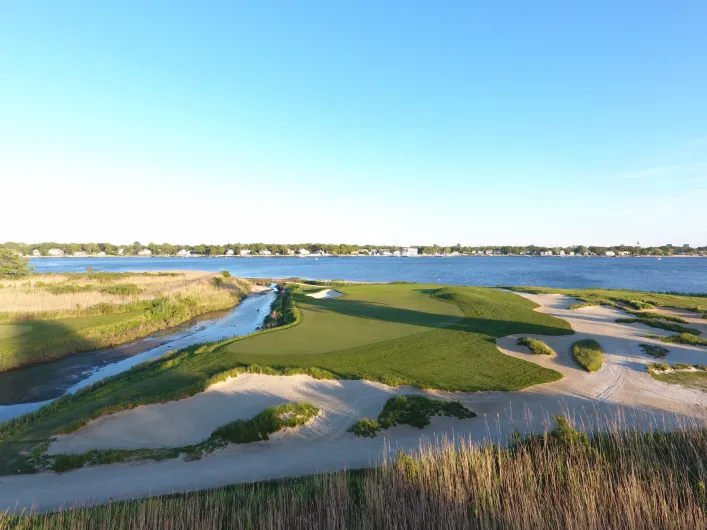Renovated Manasquan River set for '20 Four-Ball Championship

Photo: 16th Hole, Manasquan River Golf Club
When Manasquan River Golf Club in Brielle hosts the 88th NJSGA Four-Ball Championship, Tuesday-Thursday, May 5-7, 2020, it will kick off one of the most highly anticipated seasons in the 121 year history of the association. Boasting a slate of 24 championship competitions, the NJSGA visits some of the finest clubs in the Garden State; Arcola (Men’s Amateur), North Jersey (Men’s Mid-Amateur), Morris County (Women’s Amateur and Mid-Amateur) and Knickerbocker for the centennial playing of the Open Championship.
For the membership and staff of Manasquan River, hosting the Four-Ball Championship represents the unveiling of a newly renovated golf course that is the byproduct of visionary leadership and precise planning by the club’s board and staff. Always recognized as one of the finest venues along the Jersey Shore, the golf course and beautiful clubhouse have represented a combination of top-notch hospitality and championship golf for nearly a century.
Designed by Robert White and opened in 1923, the golf course is bisected by Riverview Drive. The clubhouse and holes 1-11 and 18 lie on the north side of the road; holes 12-17 are on the south side of the road, along the banks of the Manasquan River. The north side of the property includes the highest point on the Atlantic Seaboard (between Atlantic Highlands and Florida); its rolling hills and magnificent vistas of the waterfront and Atlantic Ocean are well-known. The south side of the property (holes 12-17) is next to the river; each hole plays toward or away from the water where a persistent wind is obvious.
Enhancements to a Classic Course
With major upgrades needed to the infrastructure (the irrigation and drainage systems), plus a desire to enhance the course, the club’s board introduced a master plan in 2015 to focus on long-term improvements. The first phase was to alleviate drainage challenges and improve the irrigation system. Ponds were dredged in order to address environmental issues, and to create an additional water source. A new pump-house was built and 700 sprinkler heads were added, allowing the entire course to be irrigated in 2.5 hours, as opposed to 7.5 hours.
Playability was also dramatically improved. New liners and the Capillary drainage system were installed in all 48 bunkers on the course, making them more consistent and easier to maintain. The Australian Raking system (where sides of bunkers are raked smoothly) was also instituted, which prevents balls from plugging.
Tees and green complexes were also addressed. New tees were built, leading to an increase in total yardage to nearly 7,100 yards. On holes two and three, the greens were re-built to address steep sloping and add new hole locations. The topography leading up to the greens on these two holes was also changed; ledges were crafted in the hillside 40-60 yards from each to prevent balls from rolling backwards. The 16th green, which was built when the hole was reconfigured in the early 2000s, was also rebuilt.
“We started with the drainage issue but then we decided this was the opportunity to create a new master plan for the entire course. We felt this was the time to bring in a new architect, before we put shovels in the ground,” said Peter Gacos, Manasquan River’s president at the time of the project who was involved from start to finish.
Visionary Planning
Gacos credited his collegues for their vision, and meticulous consideration in hiring an architect.
“The Board was very proactive addressing the long-term health of the golf course. After interviewing three architects, we hired Andrew Green and to look at Holes 14, 15 and 16. He really had a vision for the course, and not only addressed the drainage issues but enhanced the holes based upon the natural terrain, and also on today’s technology. From there, we did a test design – and then decided to renovate the rest of the course.
“We were thinking more long term than short term, and wanted to incorporate all the changes through a cost-effective approach – as opposed to doing all this work and implementing any changes as needed.
"It would have been economically irresponsible to address the irrigation and bunkers without first consulting with a professional architect for input on course enhancements. The approach led to a substantial cost savings doing the project all at once. And, everything we did helps lower the man-hours it takes to maintain the golf course,” Gacos added.
Head PGA Professional Chris Dymek pointed out another improvement. “There was also substantial tree removal which has allowed for better turf conditions. The rough has improved substantially –it’s gotten to a consistent level and presents another challenge of a relatively small, traditional golf course.”
After all the irrigation pipes were laid in August, 2018, the construction phase began and the heavy equipment was brought in. The process lasted until the end of January of 2019, which was followed by sodding. Four months later, the entire project – which in some way affected nearly every hole on the course – was completed, and Manasquan River was ready for play.
“We did everything without affecting play, and finished on-time and under budget. That was due to the technology and the coordination of the contractors. Andrew Kelly, chairman of the long-range planning committee oversaw that massive effort," explained Gacos.
In its nearly 100 year history, Manasquan River has been the site of a number of NJSGA major championships, including the Amateur (1993, 1980, 1969), the Open (2012) and the Mid-Amateur (2004). It has also hosted the NJSGA Women’s Senior Amateur (2013) and the Compher Cup match vs. Golf Association of Philadelphia (2001, 1983). Always a stern test of golf, the many nuances and a more modern, challenging layout faces the 2020 Four-Ball contestants.
